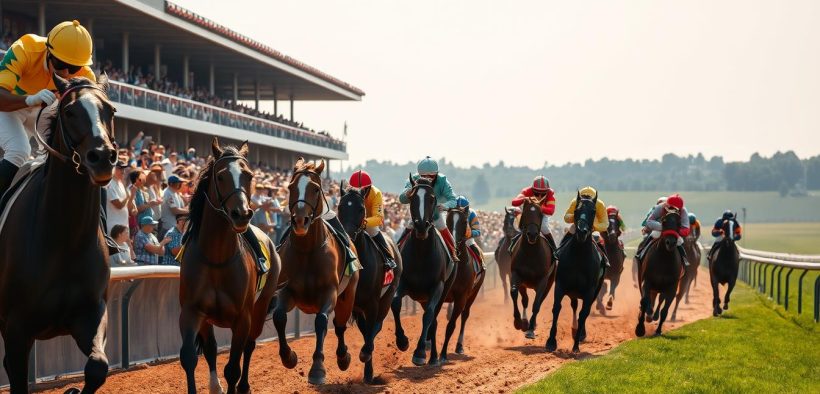Our Guide to Top Jockeys This Season’s Best Riders

Our Guide to Top Jockeys This Season’s Best Riders
Horse racing fans know elite riders shape the sport’s most thrilling moments. This guide celebrates the skill and dedication of the world’s finest competitors, blending data-driven insights with stories that captivate enthusiasts. Whether you’re new to the track or a lifelong fan, understanding what makes these athletes stand out adds depth to every race.

To rank the best, analysts rely on trusted sources like the Longines World’s Best Jockey Award. This prestigious honor evaluates performances in the 100 highest-rated Group 1 races globally. Points are awarded for podium finishes—12 for first place, 6 for second, and 4 for third—creating a clear benchmark for excellence.
Oaklawn Hot Springs’ race statistics and historical comparisons further refine the analysis. By examining earnings, win consistency, and international standings, patterns emerge that highlight true mastery. These metrics tell a story beyond speed, revealing adaptability and strategy under pressure.
Throughout the year, this guide will explore rising stars, evolving trends, and the qualities that separate good riders from legendary ones. From Kentucky Derby prep races to Belmont Stakes showdowns, join us in appreciating the athletes who make every second count.
Overview of Elite Jockey Performances
Behind every great rider lies a legacy of calculated decisions and split-second timing. To truly grasp their impact, we must explore how their achievements are measured across eras.
Tracking Excellence Through Numbers
Modern ranking systems trace their roots to early 20th-century recordkeeping. Wins, podium finishes, and earnings became the first benchmarks. The Longines World’s Best Jockey Award later refined this approach with its 12-6-4 scoring model:
- 12 points for Group 1 race victories
- 6 points for second-place finishes
- 4 points for third-place results
This structure rewards consistency in high-stakes events. Champions like Ryan Moore and Lanfranco Dettori built reputations through repeated top-three placements rather than single wins.
Awards as Cultural Compasses
Prestigious honors do more than recognize skill—they shape how audiences perceive athletic mastery. The Longines system’s focus on international Group 1 races creates a universal standard. Historical data reveals patterns: riders who excel in wet conditions often dominate autumn championships, while speed specialists thrive in summer meets.
By studying these trends, fans gain context for current competitions. Past strategies inform today’s races, creating bridges between generations of competitors.
Analysis of Longines World’s Best Jockey Award Rankings
The Longines World’s Best Jockey Award offers a precise lens to evaluate racing excellence across continents. Its scoring system transforms raw performance into a narrative of adaptability and precision, revealing who thrives when stakes peak.
2024 Rankings Breakdown and Points Distribution
James McDonald currently leads with 160 points, fueled by 10 Group 1 victories this year. Close behind, Ryan Moore holds 150 points—a testament to his relentless consistency. The 12-6-4 scoring structure rewards:
- 12 points per first-place finish
- 6 points for second
- 4 points for third

McDonald’s edge comes from converting 70% of his podium finishes into wins. Moore’s strategy focuses on frequent placements, securing points across 14 races. This duality shows how different paths yield elite results.
Comparative Trends from Past Years
Historical data reveals shifting dynamics. In 2022, Lanfranco Dettori dominated autumn races with wet-track expertise, earning 158 points. Last year, Moore leveraged summer speed circuits to clinch the title. Now, McDonald’s balanced approach—excelling in diverse conditions—marks a new trend.
Longines’ transparent methodology ensures rankings reflect true skill, not fleeting luck. As fresh talents rise, veterans adapt, proving that every race reshapes legacies in this timeless sport.
Showcasing Top Jockeys This Season
The spotlight shines brightest on those who consistently deliver under pressure. This year’s racing circuit has seen remarkable athletes rise to the occasion, blending strategy with split-second decision-making. Their stories reveal how dedication transforms potential into legacy.

Masters of the Track
James McDonald leads with 10 Group 1 victories, securing 160 points through precision in diverse conditions. His 70% win conversion rate in podium finishes highlights an unmatched ability to seize opportunities. This season, he dominated both turf and dirt events, proving adaptability is his greatest asset.
Ryan Moore’s 150 points showcase relentless consistency across 14 high-stakes competitions. Known for tactical brilliance, he turned seven second-place finishes into valuable scoring momentum. His career earnings now exceed $28 million, reflecting decades of elite-level execution.
- William Buick: 140 points with 8 wins, including a historic Belmont Stakes triumph
- Flavien Prat: 18% improvement in top-three finishes compared to last year
- Frankie Dettori: 200th career victory achieved at Royal Ascot
Buick’s recent milestones underscore his evolution from promising talent to seasoned strategist. Meanwhile, emerging riders like Prat demonstrate how data-driven adjustments elevate performance. These athletes don’t just win races—they redefine excellence through every turn.
In-Depth Look at Oaklawn Hot Springs Rankings
Success at Oaklawn Hot Springs demands more than speed—it requires mastery of unpredictable tracks and fierce competition. Recent data reveals how riders like Francisco Arrieta and Cristian A. Torres turn grit into measurable results. Their stats paint a vivid picture of skill meeting opportunity.

Performance Statistics and Earnings Analysis
Arrieta’s 18% win rate across 210 starts this year earned him $2.1 million, showcasing his ability to convert effort into rewards. Cristian A. Torres followed closely with $1.8 million from 189 races, proving consistency pays. Rafael Bejarano’s 45% top-three finish rate highlights his knack for staying competitive even in challenging events.
Win Percentage and Top 3 Finishes Overview
Victories matter, but podium placements often define careers. Arrieta secured 38 top-three finishes, while Torres landed 34. Bejarano’s 27 wins paired with 62 podium appearances demonstrate endurance under pressure. These metrics align with broader trends—riders prioritizing steady performance now see higher earnings growth year-over-year.
Oaklawn’s grueling circuit rewards adaptability. By balancing risk and precision, these athletes prove that every race reshapes legacies in this ever-evolving sport.
Global Perspectives and Emerging Talents
Global competitions reveal unique styles shaping modern racing. While established champions dominate headlines, fresh faces from unexpected regions redefine what’s possible. This dynamic interplay between experience and innovation creates thrilling narratives for fans worldwide.
International Rankings and Cross-Country Comparisons
Australia’s James McDonald leads with 160 points this year, showcasing precision in both Melbourne Cup and Royal Ascot events. Great Britain’s Ryan Moore follows closely at 150 points, demonstrating adaptability across Europe’s turf circuits. Japan’s Yuga Kawada emerges as a standout, climbing 12 ranking spots since 2023 through disciplined pacing strategies.
Racing cultures influence performance metrics. European riders often excel in endurance-focused events, while Asian competitors dominate sprint-heavy formats. These differences highlight how regional preferences shape training methods and race-day tactics.
- Tom Marquand (GBR): 22% increase in international wins since 2022
- Joao Moreira (BRA): 14 podium finishes across 5 countries this year
- Rachel King (AUS): First woman to rank in global top 20 since 2019
Such achievements reshape how audiences perceive success. When Japan’s Christophe Lemaire won France’s Prix de l’Arc de Triomphe, it sparked renewed interest in cross-training techniques. These moments remind us that racing’s future lies in embracing diverse approaches to excellence.
Conclusion
Racing legends aren’t born overnight—they’re forged through years of split-second decisions and evolving strategies. This year’s analysis reveals how historical benchmarks and modern metrics intersect to define greatness. The Longines scoring model and Oaklawn’s grueling circuits highlight how adaptability defines success, with riders like James McDonald and Francisco Arrieta balancing consistency across diverse conditions.
Global trends underscore racing’s dynamic nature. Emerging talents from Japan and Australia challenge established stars, while historical data shows endurance often outpaces short-term streaks. The 12-6-4 points system rewards tactical brilliance, as seen in Ryan Moore’s 14 podium finishes and Rachel King’s groundbreaking rise.
From earnings growth to cultural shifts, these insights deepen appreciation for the sport’s rigor. As new strategies emerge and records fall, every race becomes a chapter in racing’s ongoing story. Follow the action ahead—where fresh faces and seasoned champions alike continue pushing boundaries, ensuring the thrill of competition remains timeless.
FAQ
How are jockeys ranked in major competitions?
Rankings rely on race wins, podium finishes, earnings, and points from events like the Longines World’s Best Jockey Award. Metrics such as win percentages and consistency in high-stakes races also play critical roles.
What determines the Longines Award points system?
Points are awarded based on performances in Grade 1 races globally. First place earns 12 points, second place 6, and third place 4. Cumulative totals across eligible events decide annual standings.
Who leads current standings in 2024?
Ryan Moore and William Buick remain front-runners due to dominant showings in European and international races. Their success in events like the Dubai World Cup and Breeders’ Cup has solidified their positions.
How do Oaklawn Hot Springs rankings differ?
Oaklawn focuses on regional U.S. performances, emphasizing earnings per start and top-three finishes. Jockeys like Cristian Torres and Francisco Arrieta excel here due to consistent results at the Arkansas track.
Are emerging talents gaining recognition globally?
Yes. Japanese rider Yuga Kawada and Australian James McDonald have risen through rankings with victories in marquee events. Their adaptability across turf and dirt surfaces highlights their growing influence.
Why do award systems matter for jockey careers?
Awards like Longines boost visibility, sponsorship opportunities, and reputations. Recognition often leads to partnerships with elite trainers and owners, directly impacting future race opportunities.





